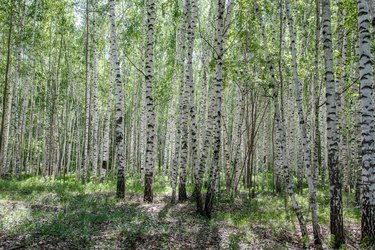
Birch trees are well known for their slender trunks, papery bark and small, delicate leaves. The most well-known birch has a distinctive white trunk with black markings and leaves that turn a bright yellow in the fall, but trees of the birch family (Betula, USDA plant hardiness zones 2 to 6) sport a variety of bark colors in grey, black, brown, red and yellow. Birch trees are native to the entire Northern Hemisphere and can be used in a number of applications, from woodworking to medicine; birch bark has been used as paper or as a bandage by many cultures throughout history.
Birch Tree Growth
Video of the Day
Birch trees prefer colder climates, although some varieties may be found in the Southern United States; they are shallowly rooted and will continue to grow during both waterlogged seasons and droughts alike, as long as the weather doesn't extend too long at either extreme. Some birch varieties grow in single, slender trunks, often spaced closely together, while others grow in clumps in which multiple individual trunks emerge from the same central trunk and root system underground.
Video of the Day
Although birch trees may be difficult to propagate when using cut branches, it is possible to propagate birch trees by taking cuttings of an existing tree. Birch cuttings have over a 50 percent chance of growing successfully if the cutting is taken appropriately.
Taking Birch Cuttings
Look for a younger branch that has a condition called greenwood, softwood or semi-ripe; a branch like this is young enough to bend, but will still snap when it is bent too far. Look for new growth on a branch that is flexible to the touch; take the newest end of the branch, and then cut off three or four leaf nodes, which will usually be about 6 to 8 inches long. Cut with sharp pruning shears directly under a leaf node, (no more than a 1/4 inch below).
Once you have your cuttings, remove the leaves from the bottom two-thirds of the branch. You'll want to immediately wet a few inches of the cut end and treat it with rooting hormone; if you can't do this immediately, store cuttings in a plastic bag with some moisture and keep them in cool shade. If a cutting dries out, its chances of success drop drastically.
Planting Birch Cuttings
Prepare pots a few inches deep with an equal mix of sand and peat moss; make sure the pot has drainage holes. Wet the mixture beforehand to ensure the soil is moistened. Make a hole around 3 inches deep in the pot with your finger or a pencil, then put your cutting into the hole and gently press soil around it. You may plant multiple cuttings in one pot, since some will not take.
Keep the soil moist at all times to help the cuttings root. You may want to mist the remaining leaves and use a clear plastic bag to act as a greenhouse while the cuttings adjust. Keep them out of direct sunlight so that they don't dry out; indirect sunlight is best. Birch cuttings enjoy temperatures around 70 degrees Fahrenheit.
You may see new leaf growth on the stem, or note that when the stem is gently tugged, it doesn't move; both things are signs of root growth. It will likely take six to eight weeks before the cuttings are ready to be transplanted.